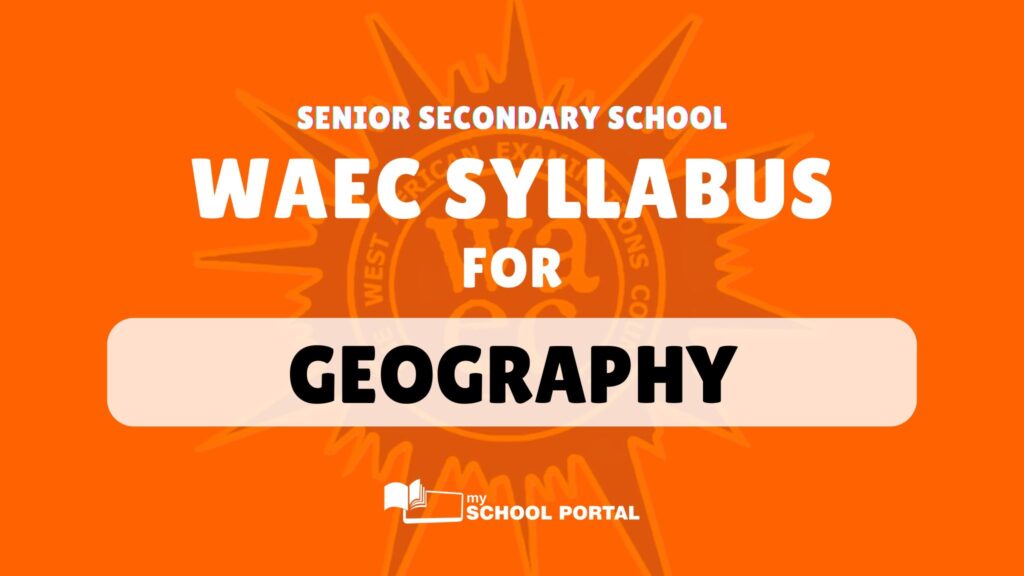The WAEC Syllabus for Geography is designed to evaluate candidates’ knowledge of the features of the earth’s crust (internal and external), the spatial spread of the physical and human features, the interactions that exist between man and these spatial features, the changes that occur over space as well as the effects of those changes on man with a view to maintaining sustainability in man’s ecosystem. This examination syllabus is based on the assumption that not less than three hours of teaching per week will be allocated to the subject.
The examination will test the candidates’ ability to:
- explain the concepts of differential character and the spatial relationships of the surface features of the earth;
- explain the concepts of man- environment relations (i.e. to analyse the life of man within his physical and cultural environments and to explain their interactions);
- demonstrate a basic knowledge of the nature and functioning of physical and human environments, particularly an understanding of their inter-relationships and the resulting issues;
- organize and formulate principles according to acquired geographical concepts and then apply these principles to interpret and analyze spatial problems in the immediate and wider environments;
- demonstrate skills and techniques for accurate, orderly and objective geographical investigations to be carried out both in the classrooms and in the immediate environment;
- communicate geographical ideas effectively through reports, graphs, charts, sketches, diagrams and maps;
- explain the cultural, social and economic circumstances of people in their immediate environments and those of other countries within the sub-region.
There will be three papers, Papers 1, 2 and 3 all of which must be taken. Papers 1 and 2 will be a composite paper to be taken at one sitting. Paper 1 will consist of fifty objective questions to be taken in 1 hour for 50 marks. The questions will be drawn from topics in the syllabus that are common to all the member countries. Candidates will be required to attempt all the questions. Paper 2: will contain nine essay-type questions out of which candidates will be required to answer four in 2 hours for 80 marks.
It will be made up of two sections; Sections A and B for candidates in Nigeria and three sections; Sections A, B and C for candidates in Ghana, Liberia, Sierra Leone and The Gambia. Candidates in Nigeria will be required to attempt four questions in all, choosing two questions from each of Sections A and B. Candidates in Ghana, Liberia, Sierra Leone and The Gambia will be required to attempt four questions in all, choosing at least one question from each of Sections A, B and C.
The questions will be distributed in the sections as follows:
Section A: Economic and Human Geography: This will consist of three essay-type questions on Economic and Human Geography. Candidates in Nigeria will be required to attempt any two of them while candidates in Ghana, Liberia, Sierra Leone and The Gambia are to attempt at least one of the questions
Section B: Regional Geography of Candidate’s Home Country: There will be a set of three essay-type questions on Regional Geography on each of Ghana, Liberia, Nigeria, Sierra Leone and The Gambia. Candidates in Nigeria will be required to answer two of the questions on their country while those in the other countries will answer at least one out of the sets for their countries.
Section C: Regional Geography of Africa: There will be three essay-type questions drawn from Africa for candidates in Ghana, Sierra Leone, Liberia and The Gambia out of which candidates are expected to answer at least one.
Paper 3 Element of Practical and Physical Geography: Will consist of eight essay-type questions out of which candidates are to answer four in 1 hour 50 minutes for 70 marks. Question 1, on map reading and interpretation, will be compulsory for all candidates and will carry 25 marks while the other questions will carry 15 marks each. Candidates are advised not to spend more than 35 minutes on Question 1. Candidates will be expected to bring graduated rulers (both metric and imperial), a complete mathematical set, a piece of string and a simple non-programmable calculator for use during the writing of the paper.
Detailed WAEC Syllabus for Geography
- Elements of practical and physical geography
- Map work (Maps: meaning, types and uses. Map reading and interpretation)
- Maps: meaning, types and uses. Map reading and interpretation
- Principles of elementary surveying
- Geographic Information System (GIS)
- Statistical maps and diagrams
- Elements of Physical Geography
- Hydrosphere
- Rocks
- Tectonic processes
- Denudational processes
- Weather and climate
- Climate
- Elements
- Classification
- Climate change
- Vegetation
- Soil
- The environment
- Environmental resources
- Environmental problems/ hazards
- Environmental conservation
- Economic and human geography
- World Population
- Settlement
- Transportation
- Industry
- Trade
- Tourism
Aspects of regional geography peculiar to member countries
- Regional geography of Nigeria
- Nigeria on broad outline
- Physical setting
- Population
- Resources
- AgricultureTransportation
- Communication
- Industry
- Trade
- Tourism
- Issues on development and environmental concerns
- ECOWAS
- Geo-political issues
- Regional geography of Ghana
- Ghana on broad outline
- Lumbering
- Mining
- Manufacturing
- Trade and commerce
- Tourism
- Energy and power
- Issues on development and environmental concerns
- Regional geography of Sierra Leone
- Sierra Leone on broad outline
- Primary economic activities (i)Agriculture
- Fishing
- LumberingMining
- Manufacturing
- Transport and communication
- Trade
- Population
- Tourism
- Regional geography of Liberia
- Liberia on broad outline
- Physical setting
- Population
- Resources
- Agriculture
- Transportation
- Communication
- IndustryTrade
- Tourism
- Fishing
- Mining
- Regional geography of Senegambia
- Senegambia on broad outline
- Physical setting
- Population
- Resources
- Agriculture
- Transportation
- Communication
- Industry
- Mining
- Fishing
- Issues on development and environmental concerns
- Trade
- Tourism
- Regional geography of Africa
- Africa on broad outline
- Selected topics
- Irrigation agriculture
- Plantation agriculture
- Oil production
- Lumbering
- Gold Mining
- Copper mining
- Population
- ECOWAS
- Field work
- Fieldwork on any one of the following topics should be based on local geography of candidate’s home country. (This aspect of the syllabus should be examined by schools as part of the continuous assessment and should account for 25% of the total mark allotted to continuous assessment).
- Land use (rural or urban):
- rural – crop farming (e.g. rice, cocoa, etc. )
- urban crop farming
- mining (e.g. coal, tin, petroleum etc.), fishing.
- urban – commercial activities, ports, factories, recreational etc.
- Market survey – rural or urban.
- Traffic flow – rural or urban.
- Patterns of journey to work – rural or urban.
- Rate of erosion in the locality
Suggested reading list
- General Geography in Diagram for West Africa. R. B. Bunnett & P.O. Okunrotifa
- Certificate Physical and Human Geography (West African Edition). B. O. Akindele & G. C. Leong
- Introduction to Physical Geography. Strahler, A. N.
- Principles of Physical Geography. Monkhouse, F. J.
Related
Stay updated with the latest student resources and insights from My School Portal! Subscribe to our newsletter for fresh content delivered straight to your inbox—no spam, just value 😊














